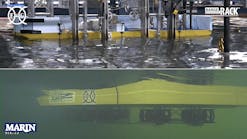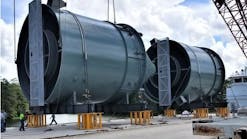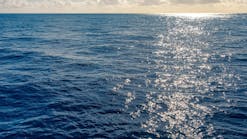New fire-resistant cables improve critical systems performance in emergency
Ted Moon - Technology Editor
While offshore drilling rigs and production platforms place high priority on reliable power at all times, this need is critical during dangerous events, such as the outbreak of fire. If critical operational and safety systems go down quickly during these events due to power loss, the chances for safe evacuation of all personnel decreases and the likelihood of loss of life rises.
Draka MOG’s Flex-Flame HCF cable.
Enter Draka Marine, Oil & Gas (MOG) International, a division of Draka Cableteq and a global provider of wire and cable products to the offshore oil and gas industry. The company has added to its product range the Flex-Flame HCF (HydroCarbon Fire) family of cables that are designed to keep critical systems working during a fire or other similar dangerous situations on a platform.
Flex-Flame HCF builds on Draka’s previous generation fire-resistant cables. The design is based on a fire-proof elastomeric cable covered with a composite-based protective coating that changes composition when exposed to higher temperatures.
Eivind Nesset, technical manager of innovation for Draka MOG, explains what happens to this composite during heating. “The cable’s unique design gives good heat transmission during normal operating temperature. If the cable is exposed to a hydrocarbon fire, rapid changes in the material state give a cooling effect, which is maintained during the critical period.”
Nesset says that during heating, the composite-based protective sheath changes in composition from an elastic substance into a firm, ceramic substance that provides heat insulation to the cable inside. “This ceramic layer is capable of withstanding hydrocarbon fires at greater than 1,100°C, and of preventing the copper wire inside the elastomeric cable from seeing temperatures anywhere near that.”
This is an important property, given that copper has a melting point of about 1,050°C. This insulating effect is not infinite. The cable eventually fails from continued exposure to high temperatures. However, Nesset says that these cables will provide reliable power at 1,100°C long after the critical time period for safe evacuation. For example, ExxonMobil requires functional security of power supplies for 15 min. at a temperature of 1,100°C, with a heat flux of 160 kW/m2. While most heat-resistant cables might break down after 2 to 6 min. at this temperature, Draka MOG says all Flex-Flame HCF cables are rated to withstand this condition for up to 60 min.
Draka MOG has other cable products in the HCF family which can perform well beyond 60 min. There are the 250 V and 1 kV BFOU-HCF series which contain a mica glass tape; these pass the International Electrotechnical Commission’s (IEC) gas flame test 60331-31 with hammer shock for 120 min. at 850°C without short circuiting. An upgraded version of this cable can pass the IEC gas flame test at 1,000°C for 3 hours.
The high temperature resistance of these cables, coupled with the fact that they are easy to install and terminate, made the Flex-Flame HCF a New Technology Award recipient at this year’s Offshore Technology Conference.
For more information, visitwww.DrakaMOG.com or contact Mike O’Brien at [email protected] or at +281-645-7385.







